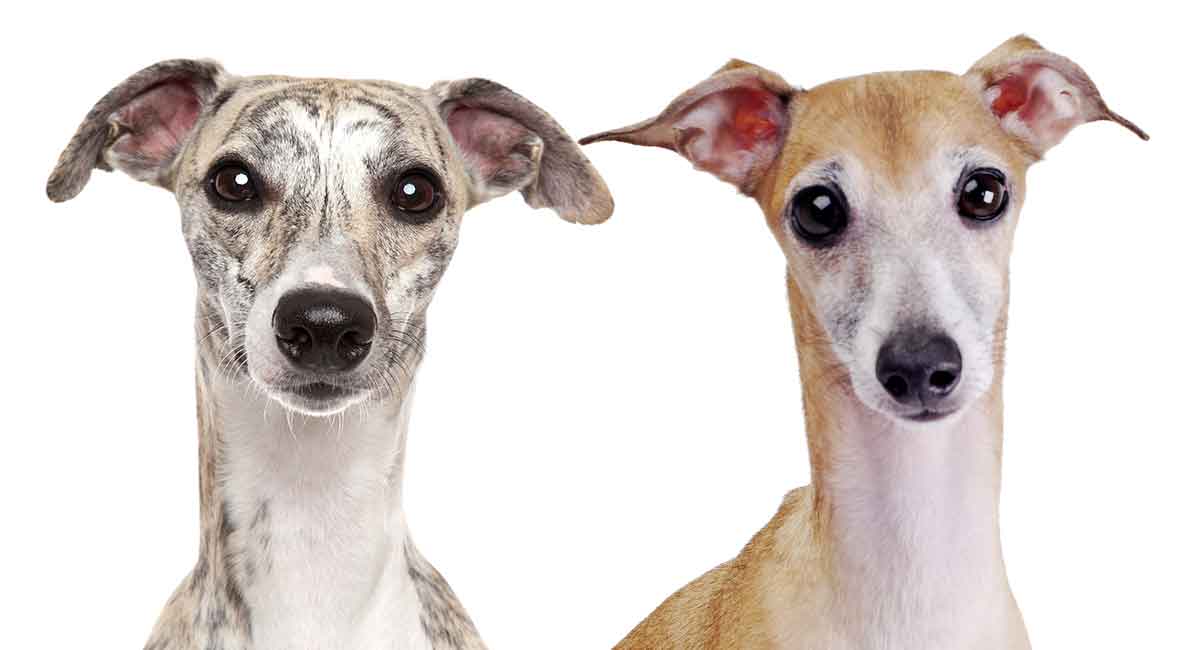
All Italian Greyhound and Whippet owners have their dogs regularly mistaken for the other breed. They are both short, skinny speedsters, with tipped ears and a tail often tucked between the legs. Long noses and elegant necks give them an alert stance, and they both always appear ready to run. But if you get to know them better, you’ll find a surprising number of differences emerge when comparing the Italian Greyhound vs Whippet.
Contents
- Similar looks, shared history
- One is bigger than the other
- Coat and grooming
- Differences in personality
Similar Appearances
The Whippet and Italian Greyhound each look a lot like a Greyhound, minus the towering stature. Both have deer-like legs, swan-like neck, long and arching back. As well as a short and sleek coat, upright yet folded ears, and large, expressive eyes. And let’s not forget the rat-like tail that flies behind when they’re in motion!
It’s All Relative
There’s a reason why the Whippet and Italian Greyhound look so much alike – they are, indeed, all cousins! These breeds can trace their roots to the earliest sighthounds, which are thought to have been around for thousands of years.
Though the Italian Greyhound and Whippet are related, they do differ in size, likely due to their original intended usages.
The Italian Greyhound was bred to be a companion, occasional hunter, and coveted status symbol in the days of Roman-empire ruled Greece and Turkey. On the contrary, the Whippet was developed in Victorian-era England to be the “Poor Man’s Racehorse”. A slightly smaller and therefore less expensive to feed Greyhound.
Which Breed Is Bigger?
Both Whippets and Italian Greyhounds are smaller than a Greyhound. This makes them popular options for folks who like the look and feel of the Greyhound, but in a smaller package. I can also speak to the Greyhound’s almost horse-like size; one of my close friends has a Greyhound who we affectionately refer to as ‘the house pony’.
As a member of the Toy group, the Italian Greyhound will stay tiny enough to be a lap dog, reaching anywhere from 13-15 inches tall at the shoulder and weighing 7-14 pounds. As a member of the Hound group, the Whippet will grow large enough to be an effective hunter. Reaching anywhere from 18-22 inches tall at the shoulder and weighing 25-40 pounds.

Italian Greyhound vs Whippet Coats
Both Italian Greyhounds and Whippets have a very short and smooth coat which does not require much in the way of grooming. They each come in lots of hound colors, and may be solid or bi-colored, with a variety of markings.
Because both breeds have such thin coats, neither is a good fit for a very cold or damp climate. If you live anywhere that is not warm year-round, purchase either of these pooches a doggie coat to keep them nice and toasty.
Grooming
Due to their short and thin coats, both Whippets and Italian Greyhounds do fine with an occasional brushing. You’ll only need to bathe them if they happen to roll in something yucky.
Italian Greyhounds shed seasonally, if at all, and Whippets also only shed occasionally. Both of these guys should have their nails trimmed regularly to avoid the discomfort of long nails.
Whippet vs Italian Greyhound Temperament
As dogs with sighthound lineage, both Whippets and Italian Greyhounds are compelled to chase after wildlife, often without warning. This means that neither breed should be allowed to run freely, or else, you may never catch them!
Running aside, both Whippets and Italian Greyhounds are usually mild-mannered pups who are quite friendly.
Italian Greyhounds, especially, love to be near their humans and love to find a lap to doze off in. My sister-in-law’s Italian Greyhound, Ivy, makes it her mission at family gatherings to sit in every attendee’s lap for at least a few minutes!
Once they have expended some energy in short bursts, Italian Greyhounds and Whippets both can be rather lazy. They will lay around the house, and barely raise a head when someone wanders in the room.
Neither of these breeds are very vocal, but the Whippet is perhaps a little more likely to bark in my experience than the Italian Greyhound.
Differences In Health
Due to both Whippets and Italian Greyhounds being pure-breed dogs, they are predisposed to genetic health problems. With their very thin coats, both breeds are prone to hypothermia and frost bite if exposed to cold temperatures for too long. You can use dog coats and booties to protect them when they must be exposed to snow or frozen ground.
Both breeds are also susceptible to having an overbite, which requires correction in many cases in order to allow the dog to eat normally.
Whippets have been known to develop eye diseases, heart problems, and blood clotting issues. They also react negatively to anesthesia. And Italian Greyhounds easily develop tooth and gum infections if their teeth are not cleaned regularly.
Italian Greyhounds are also prone to epilepsy, leg and tail fractures, joint problems, vision loss, and hypothyroidism, and may also react poorly to anesthesia.
Whippets have a lifespan of 10-13 years, and Italian Greyhounds have a slightly longer average lifespan of 13-15 years.


Terri says
Iggie’s short for Italian greyhound are sweet little companion. I took her to a family picnic and everyone had to pet her. I’ve had four Iggie’s. Two thought they were big greyhounds and run legs straight out beautifully. All were sweet. They all have teeth issues and keep nails short. Great for seniors.
Joan LAMOUREUX says
I have 2 Italian Greyhounds, Chip and Dale. They are brothers, almost 2 years old. They are adamant about teeth cleaning and will not let me near them to clean their teeth. My husband cannot hold them at all for me to clean their teeth! I was thinking of having their teeth cleaned by my vet, but I hate having them put under😧. Any other thoughts? We’ve tried so many times to clean their teeth! Help!
Nicole says
Use a liquid with chlorhexidine to squirt in their mouth daily like clenzadent or a gel toothpaste you rub on their gums. I personally don’t like the water additives as, I don’t like the idea of them ingesting it and it it’s probably less effective and a waste of product. But with the breed’s propensity for dental problems (which can cause early death, vascular and heart problems, and horrible pain,) definitely do something routinely
Dean says
Teef in their water will address their dental issues! It promoted healthy bacteria in their mouth and combats bad bacteria that can cause health issues.
Bruh says
Whippets r pro
Mike says
I have a rescue Wippett Australian Sheppard mix and he is 9 and still has a lot of energy. He is very calm and does like to run in the dog park. He is dog and people friendly
H like chacing cats rabbets and lizards. He is a great dog Nd loves walks
Dog lover ❤️ says
Personally, I find whippets the perfect little dogs. There’s a elderly couple I’m friends with and they have a pair of whippets, One elder girl called bliss, and a hyperactive younger boy called Alex. Bliss is real calm and has such a timid trusting personality. Alex is, in short, a real mess, all over the place and super protective and proud of his toys. They’re so cute! 🐕🦮🐩🐕🦺🐾🦴
Lauren says
I have a Whippet x IG – the best of both! 🙂
Neville says
When speaking to a Whippet breeder, what health tests on the mother/father should I ask to see and how recent should these tests be. And before getting the Whippet puppy home, what type of vaccinations should the breeder apply. Is early crate training successful for a whippet puppy?
marianne carper says
is there any terrier in the iggy?
nicq says
No, they’re pure greyhounds just in a pocket size.
There’s a bit in whippets.